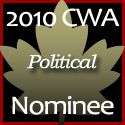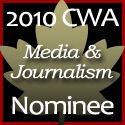I've known for some time now that the relationship between the Reform-Conservatives and the U.S. Republicans, goes back a long way. One of the top Republican pollsters, John McLaughlin, takes credit for both the careers of Stephen Harper and the success of the National Citizens Coalition, and whenever our current government needs help with anything, they head to Washington or Fox News.
President Obama snubbed Harper on his latest visit, and who came to his defense? David Frum, who wrote a piece for the National Post suggesting that it was not a snub.
Frum is the son-in-law of Peter Worthington (close friend of Conrad Black) and a former speech writer for George W. Bush. In fact, he was the one who coined the phrase 'Axis of Evil'. When Harper gave his "cut and run" speech during his first visit to Afghanistan, it was a condensed version of one given by Bush to the U.S. Naval Academy.
However, while I knew the ties ran long and deep, I was surprised to discover that Newt Gingrich actually consulted with Preston Manning, Stephen Harper and the Reform Party, before launching his bid in 1994. I'm going into that in another post, but not all of the ugliness came North. Some of it went south.
I am on the editorial board for the Kingston Whig Standard, and my last column was going to be about raising a grandson and how his toys are smarter than me, but then I did what I promised myself I wouldn't. I visited the 'Ignatieff Me' site set up by the Reform-Conservatives, and I was so appalled, I changed my piece to the ugliness that this new movement has brought to Canadian politics.
Well, I recently stumbled across an article written by an American journalist, who noticed the same thing. When Conrad Black owned half of the Canadian newspapers, he made a sharp right turn, and we've been going downhill ever since.
An American journalist's view of Harper
Richard Fricker
October 18, 2006
For inspiration in building a new brand of Canadian conservatism, Harper looked to Washington, where Rep. Newt Gingrich, R-Georgia, was promoting a combative style designed to shatter the longtime Democratic grip on the U.S. House of Representatives.
As an American journalist visiting my wife's relatives in Canada, I've always been struck by how ardently the country's political discourse focused on substance — the budget, health care, schools, roads — with little of the cheap theatrics and angry divisiveness of U.S. politics and punditry. Reading and listening to the Canadian news media during those family trips could be a tad boring, but it also was touching, like remembering your earnest grade-school civics teacher lecturing about the wonders of the American democratic process.
But in my visit this past summer, I noticed that the tone of Canada suddenly had changed. There was a nastier edge to the commentary. There were not-so-subtle appeals to racism and xenophobia, references to Muslim neighbourhoods in Quebec as “Quebecistan” and to Lebanese-Canadians as “Hezbocrats,” a play on the Muslim group Hezbollah.
To someone who has covered U.S. politics for three decades, there was a shock of recognition. Standing out starkly against the bland traditions of Canadian governance was the pugnacious 'tude of American political combat, wedge issues pounded in with a zeal that put the goal of winning and holding power over everything else.
It was as if a virus that had long infected the people south of the border had overnight jumped containment and spread northward establishing itself in a new host population. But — as I began to study this new phenomenon — it became clear that this infection did not just accidentally break quarantine. Rather, it was willfully injected into the Canadian body politic by conservative strategists and right-wing media moguls who had studied the modern American model and were seeking to replicate it.
Canada's Prime Minister Stephen Harper even brought in Republican advisers, such as political consultant Frank Luntz, to give pointers on how the ruling Conservative Party could become as dominant in Canada as the GOP is in the United States.
Canada had its version of Rupert Murdoch and Fox News in the Asper brothers and their CanWest Global Communications Corp., which owns the National Post, the Montreal Gazette and nine other Canadian newspapers, 25 television outlets and two radio stations. It was the Montreal Gazette and the National Post that trumpeted the phrase “Quebecistan” after demonstrators in Ottawa and Montreal protested Israel's bombardment of Lebanon in summer 2006.
Columnist Don MacPherson equated those protests, where some demonstrators waved Hezbollah flags, with pro-terrorism. “It's finally becoming respectable again to express support for terrorists,” MacPherson wrote on August 8, 2006, in the Montreal Gazette.
Meanwhile, CanWest's National Post offered up a Canadian version of Ann Coulter in columnist Barbara Kay (Kay was also a recipient of the National Citizens Coalition Colin Brown Award).
In one of Kay's columns, she noted that 50,000 Lebanese-Canadians lived in Montreal and added, “We can expect those numbers to swell as Hezbollah-supporting residents of southern Lebanon cash in on their Canadian citizenship and flee to safety.”
Kay denounced Quebec as “the most anti-Israel of the provinces and therefore the most vulnerable to tolerance for Islamist” causes. “The word would go out to the Islamophere that Quebec was the Londonistan,” Kay wrote. “It won't if our political class takes its cues from principled Stephen Harper rather than shameless Quebec politicians who led the pro-terrorist rally.” '
Clone de Bush' Harper, Canada's photogenic 47-year-old Prime Minister, has emerged as the face of modern Canadian conservatism much the way George W. Bush has come to personify right-wing politics in the United States.
Born in Toronto in 1959, Harper moved west to Alberta in 1978 to work in the petroleum industry. Similarly, Bush cut his teeth as a Texas oilman, albeit a failed one. Much as that oilfield experience shaped Bush's persona and Texas money fueled the American Right, so too did Alberta and its oil industry influence the political development of Harper and the emergence of modern Canadian conservatism.
Harper earned a bachelor's degree and his masters in economics from the University of Calgary. By 1985, then in his mid-20s, he had turned to politics, gaining recognition as a bright operative and landing a job as chief aide to a Tory Member of Parliament named Jim Hawkes.
But Harper grew disenchanted with the compromising style of Canada's Tories who — like Prime Minister Brian Mulroney — often worked collaboratively with other political parties in Ottawa to maintain social programs for Canadians.
Harper concluded that Mulroney's Progressive Conservative Party was too liberal, so he quit it in 1986. At age 28, Harper was recruited by Preston Manning, the founder of Canada's Reform Party, and became the party's chief political officer. Harper ran for the House of Commons against his old mentor, Hawkes, in 1988, losing badly. But the defeat did not dampen Harper's political ambitions. He continued to puzzle over how a revamped conservative movement might shake up Canadian politics and ultimately gain power.
For inspiration in building this new brand of Canadian conservatism, Harper looked to Washington, where Rep. Newt Gingrich, R-Georgia, was promoting a combative style designed to shatter the longtime Democratic grip on the U.S. House of Representatives. In Gingrich's view, Republicans had to replace cooperation with confrontation.
In 1993, Harper ran for the House of Commons again, this time aided by a tactic pioneered by U.S. conservatives — having ostensibly independent organizations tear down one's opponent with large sums of money outside the legal limits on campaign spending. In this case, a group called the National Citizens Coalition went on the offensive against MP Hawkes, undermining his political support enough so that Harper was able to win the seat in Calgary West.
Harper was learning, too, from conservative spinmeister Frank Luntz, who helped Gingrich draft the “Contract With America,” which became the centrepiece of the Republican victory in the U.S. Congress in 1994. Luntz was a specialist at the take-no-prisoners-style of politics that envisioned permanent conservative control of Washington.
Harper picked up other tips from Bush's political adviser Karl Rove, such as the importance of transforming the Christian evangelical movement into an activist base for conservative politics.
Harper's brash conservatism grated on the more populist positions of Manning's Reform Party, which once rebuked Harper for not standing with the party's internal policies. For his part, Harper considered Manning too inclined to compromise.
In January 1997, Harper resigned his Reform Party seat in Parliament and went to work as vice president of the National Citizens Coalition, the outside organization that had helped Harper defeat Hawkes in 1993. Harper soon rose to be the coalition's president and served notice that the group would become a vehicle for smashing Canada's political status quo.
In a speech in the United States to a major conservative organization, the Council for National Policy, Harper declared that “Canada is a Northern European welfare state in the worse sense of the term, and very proud of it.” Harper also mocked Canadians as complacent and ill-informed. “If you're like most Americans, you know almost nothing except for your own country,” he told his CNP audience. “Which makes you probably knowledgeable about one more country than most Canadians.”
Back in Canada, Harper also began ratcheting up the political rhetoric, co-authoring an article referring to Canada's Liberal government as a “benign dictatorship” held together by incompetence. The article also sought conservative unity and praised the hard-edged right-wing commentary in media outlets owned by mogul Conrad Black.
Harper cobbled together a platform of issues that exploited Canada's latent social, cultural and economic resentments. He proposed raising the age of sexual consent, permitting more corporal punishment of children, initiating a program similar to school vouchers, and resisting issues that favoured French-speaking Quebec.
As this Americanized version of Canadian conservatism took shape, Harper was cribbing, too, from another rising U.S. politician, George W. Bush. Harper said his goal was to tap into a political base “similar to what George Bush tapped.”
New party Amid a surge of anti-minority sentiments, Harper merged his operations at the Canadian Conservative Alliance with those of Peter MacKay, the last leader of the Progressive Conservative Party. In 2003, they officially formed the Conservative Party of Canada.
Their timing was perfect. As with the congressional Democrats in the United States a decade earlier, the Canadian Liberal Party found itself beset with corruption allegations and suffering from growing public resentment about high taxes. In contrast to these tainted Liberals was the fresh-faced Harper at the head of a shiny new movement with powerful backing from right-wing interest groups, neoconservative media outlets and stirred-up social conservatives.
Though Conrad Black's media empire had collapsed in a financial scandal, some of his properties, such as the National Post, were snapped up by CanWest Global, which shared Black's staunchly pro-Israeli stance on Middle East affairs. Harper also brought into play evangelical Protestants, through his membership in the Christian and Missionary Alliance, which opposed gay rights, was staunchly anti-abortion and targeted North Africa's Muslims for conversion to Christianity.
In 2004, Harper engineered a political breakthrough for the Conservatives in Ontario, boosting their standing in the House of Commons by 25 seats. This new conservative coalition flexed its muscles again in January 2006, denying the Liberals control of Parliament by claiming 124 seats (out of 308) and putting Harper in position to piece together a coalition government, which he did.
Harper was sworn in as Canada's new Prime Minister on February 6, 2006, consolidating right-wing political power across the North American continent. President Bush finally had a likeminded Canadian leader who also shared Washington's neoconservative doctrine for confronting the Islamic world.
The tone of Canadian political discourse has followed this shift in the government, especially with CanWest media outlets ready to trumpet news that puts the Islamic world in the worst possible light. For instance, on May 19, 2006, the National Post published a front-page article by expatriate Iranian journalist Amir Taheri, claiming that Iran was enacting legislation that would require colour-coded “badges” for Christians, Jews and Zoroastrians.
“Jews would be marked out with a yellow strip of cloth sewn in front of their clothes while Christians will be assigned the colour red” and Zoroastrians would wear blue, Taheri reported in the article distributed by Benador Associates, a public relations firm representing neoconservative writers, such as Michael Ledeen and Richard Perle.
With its obvious Holocaust allusion, Taheri's story flashed around the world, picked up by the New York Post, Rush Limbaugh and the powerful U.S.-Israeli lobbying group, the American Israel Public Affairs Committee.
Harper and Australia's Prime Minister John Howard, who was visiting Canada, joined in denouncing Iran for the purported badge legislation. However, Taheri's article turned out to be untrue. The Iranian legislation contained nothing about making religious minorities wear coloured badges.
After the facts were challenged, the National Post retracted the story and later published an apology.
Media confrontation:
In June 2006, Harper applied another lesson from the U.S. Republican playbook: Even with a supportive right-wing news media protecting your flanks, still pick a fight with the rest of the national news media. Claiming to be victimized by hostile questions from Parliament Hill reporters, Harper announced that he would favour regional news outlets with interviews (Newt Gingrich does this), while shunning the supposedly “élitist” national press corps.
“I have trouble believing that a Liberal Prime Minister would have this problem, but the press gallery at the leadership level has taken an anti-Conservative view,” Harper said, ignoring the role the same journalists had played in highlighting Liberal Party corruption which cleared the way for the Conservative Party victory.
Harper mandated that reporters sign up in advance to ask questions at news conferences and then weeded out journalists considered too liberal, according to Yves Malo, president of the press corps gallery. Harper's staff “made it very clear they were taking their cue from the White House,” Malo told me.
“They were always telling us how things were done in Washington. The first time we resisted we were called 'liberals. ' Now, we're called 'liberal ideologues.'” Much as Bush speaks almost exclusively before friendly, well-screened audiences, Harper tends to grant exclusive interviews to CanWest media outlets, Malo said. Despite the lingering embarrassment over the bogus “coloured badge” story, CanWest's neoconservative attitudes resurfaced in July 2006 when war broke out between Israel and Lebanon.
As Israeli bombers inflicted heavy civilian casualties in Lebanon in retaliation for Hezbollah's capture of two Israeli soldiers, Lebanese-Canadians staged protests demanding that Israel cease its attacks.
Montreal Gazette columnist MacPherson chastised Quebec politicians who attended the rally for not condemning Hezbollah and for not discouraging Hezbollah sympathizers from participating. National Post writer Kay termed the rally “virulently anti-Israel.” Launched from CanWest's newspapers, the words “Quebecistan” and “Hezbocrats” were suddenly buzzing through Canada's public debate.
While this kind of divisive rhetoric is common in the United States and is even encouraged as a way to energize the political base, it marked an escalation of political stridency for Canada.
Some of that fury seems to have subsided since a ceasefire took hold between Lebanon and Israel in late summer. But the larger question remains whether Harper will succeed in transforming Canada into a more belligerent and bellicose nation, much as Bush has done in the United States.
For generations, Canada has prided itself on its well-liked image around the world. It is a nation renowned for sending peacekeepers abroad not occupying armies. Aside from ice hockey and occasional over-indulgence in beer drinking, Canadians are known for their civility, not combativeness.
There is also the possibility that having seen the consequences of right-wing governance in the United States, Canadians will recoil at the thought of losing their pleasant country with its national health insurance and fairly comfortable lifestyle, in favour of the more cut-throat economic system south of the border.
Some analysts suspect, too, that the Bush connection could ultimately hurt Harper, who is sometimes referred to as “un clone de Bush.” With Canadian troops dying in Afghanistan and violence rising in the Middle East, Harper's coziness with Bush may become a liability as it has been for British Prime Minister Tony Blair.
Over the past several months, Harper has seen his popularity decline and the backing of his coalition partners erode. It remains to be seen if Harper's American-style conservatism can survive — let alone thrive — in Canada. The Liberal Party — after selecting new leadership in December — is expected to force a new round of elections early in 2007.
That election may well turn out to be a test of whether the American brand of conservatism has a future as a political export. (Richard L. Fricker is a two-time winner of the American Business Press Editors Award for Investigative Journalism and writes regularly for the Swiss newsweekly Sonntags Blick. This article is reprinted, with permission, from Consortium News.)



No comments:
Post a Comment